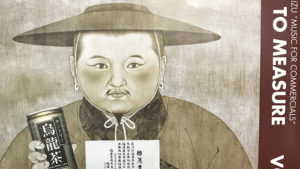Auf Vinyl und CD nun wieder zu moderaten Preisen erhältlich, dieses kleine Juwel des wunderbaren belgischen Labels „Made To Measure“, das in den 80er Jahren schillernde Exkursionen in den Grenzgebieten von Avantgarde, Pop und Post-Pop verbreitete. Im Falle von Yazuaki Shimitsu ist solche Musik für den Kommerz (Jingles, Mini-Soundtracks etc.) mit hintersinnig doppelten Böden nicht so paradox, wie es erscheint, und auch schon früher realisiert worden: die begrenzte Zeit, das zu bedienende, mögliche Objekt der Begierde, solche vermeintlich einengenden Auftragsarbeiten haben die Kreativität oft auf verlockende Abwege geführt, Sinn gemacht und (Be)-Sinnlichkeit hergestellt, in prägnanten Dosierungen. Eben nicht NUR skurril! Und wie gute Filmmusik kann sie sich von den bewegten Vorlagen lösen. (im comment one eine treffliche Besprechung von Alan aus „Modern Vinyl“)
